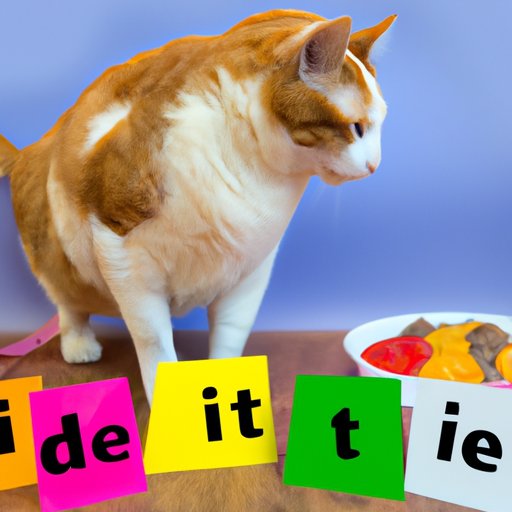Introduction
Keeping cats at a healthy weight is important for their health and wellbeing. If your cat is overweight, you may be considering putting them on a diet. This article provides pet owners with the necessary information to safely put their cat on a diet and achieve their desired weight.
Talk to Your Vet
Before starting any diet plan for your cat, it is important to consult your veterinarian. Your vet can provide personalized advice based on your cat’s individual needs and medical history. They can also help you create an appropriate meal plan for your cat and suggest ways to increase their activity level.
When consulting your vet, ask questions such as: what should my cat’s ideal weight be? How many calories should they consume each day? What types of food are best for them? Are there any special considerations I should make while creating a diet plan?
Monitor Calorie Intake
Once you have talked to your vet and created an appropriate meal plan, you will need to measure the amount of food you give your cat each day. Generally, cats require 20 – 35 calories per pound of body weight per day. For example, an 8-pound cat should consume between 160 and 280 calories per day.
To ensure your cat is receiving the correct number of calories each day, you should use a food scale to accurately measure the amount of food given. It is important to never guess when measuring food, as this can lead to overfeeding and unhealthy weight gain.
Divide Meals into Smaller Portions
Dividing your cat’s meals into smaller portions throughout the day can help keep them feeling full without overeating. Cats naturally prefer to eat multiple small meals throughout the day, so providing them with several smaller meals can help reduce their overall caloric intake while still satisfying their hunger.
For example, if your cat requires 250 calories per day, you can divide those calories into four meals of 62.5 calories each. You can also supplement these meals with treats, such as low-calorie cat treats, to reward good behavior. However, it is important to monitor the number of treats given to ensure your cat does not exceed their recommended daily caloric intake.
Limit Treats
Treats should only be given as rewards for good behavior, and should not be used to replace meals. If you are using treats as rewards, aim to give your cat no more than 10% of their daily calorie allowance. Be sure to choose low-calorie treats that are nutritionally balanced and free of artificial ingredients.
It is also important to avoid feeding your cat “people food.” Human food is often high in fat and calories, which can lead to unhealthy weight gain. If you want to give your cat a special treat, opt for a low-calorie cat treat instead.
Increase Exercise
Increasing your cat’s activity level is an important part of any diet plan. Providing toys and scratching posts can encourage your cat to be more active. You can also play with them using laser pointers or fishing pole toys. Just be sure to provide plenty of rest time in between activities.
Exercise can help your cat burn excess calories, build muscle mass, and maintain a healthy weight. Studies have shown that cats who get regular exercise have a healthier heart, lungs, and digestive system, as well as improved mental wellbeing.
Switch to Low-Calorie Food
When creating a diet plan for your cat, consider switching to a low-calorie food. Low-calorie cat foods are specially formulated to provide cats with the same nutrition they need while reducing the number of calories they consume. These foods are typically higher in fiber and lower in fat than regular cat food, making them a great option for cats who are trying to lose weight.
When choosing a low-calorie cat food, look for one that is made with natural ingredients and rich in protein. Avoid foods that contain fillers, preservatives, and artificial flavors, as these can be harmful to your cat’s health.
Monitor Progress
Once you have implemented the above steps, it is important to monitor your cat’s progress. Weighing your cat regularly can help you determine whether or not your diet plan is working. You should also monitor their activity level and eating habits to make sure they are getting the nutrition they need.
If you notice your cat is not losing weight after implementing a diet plan, talk to your vet. They may recommend adjusting the meal plan or increasing the amount of exercise your cat gets.
Conclusion
Putting your cat on a diet is important for their health and wellbeing. The steps outlined in this article can help pet owners safely put their cat on a diet, including talking to your vet, monitoring calorie intake, dividing meals into smaller portions, limiting treats, increasing exercise, switching to low-calorie food, and monitoring progress.
By following the above steps, pet owners can help ensure their cat maintains a healthy weight and lives a long, happy life.
(Note: Is this article not meeting your expectations? Do you have knowledge or insights to share? Unlock new opportunities and expand your reach by joining our authors team. Click Registration to join us and share your expertise with our readers.)
